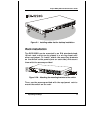
24-port NWay Ethernet Switch User’s Guide
2 Introduction
Gigabit Ethernet Technolog
Gigabit Ethernet is an extension of IEEE 802.3 Ethernet
utilizing the same packet structure, format, and support
for CSMA/CD protocol, full duplex, flow control, and
management objects, but with a tenfold increase in
theoretical throughput over 100Mbps Fast Ethernet and a
one hundred-fold increase over 10Mbps Ethernet. Since it
is compatible with all 10Mbps and 100Mbps Ethernet
environments, Gigabit Ethernet provides a
straightforward upgrade without wasting a company’s
existing investment in hardware, software, and trained
personnel.
The increased speed and extra bandwidth offered by
Gigabit Ethernet is essential to coping with the network
bottlenecks that frequently develop as computers and their
busses get faster and more users use applications that
generate more traffic. Upgrading key components, such as
your backbone and servers to Gigabit Ethernet can greatly
improve network response times as well as significantly
speed up the traffic between your subnets.
Gigabit Ethernet enables fast optical fiber connections to
support video conferencing, complex imaging, and similar
data-intensive applications. Likewise, since data transfers
occur 10 times faster than Fast Ethernet, servers outfitted
with Gigabit Ethernet NIC’s are able to perform 10 times
the number of operations in the same amount of time.
In addition, the phenomenal bandwidth delivered by
Gigabit Ethernet is the most cost-effective method to take
advantage of today and tomorrow’s rapidly improving
switching and routing internetworking technologies. And
with expected advances in the coming years in silicon


















